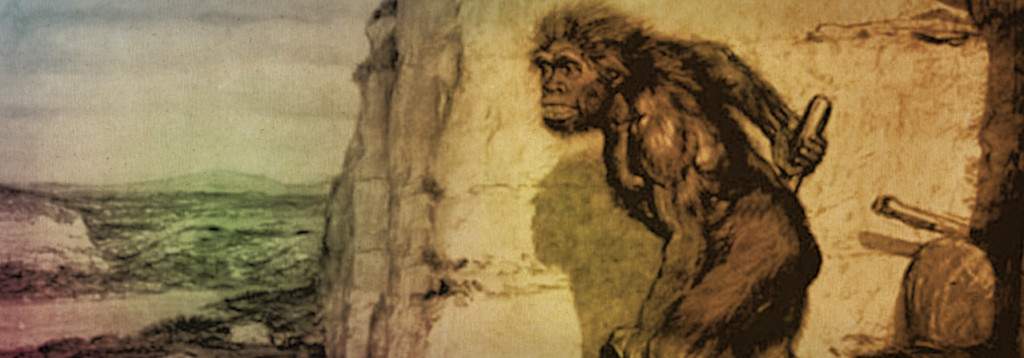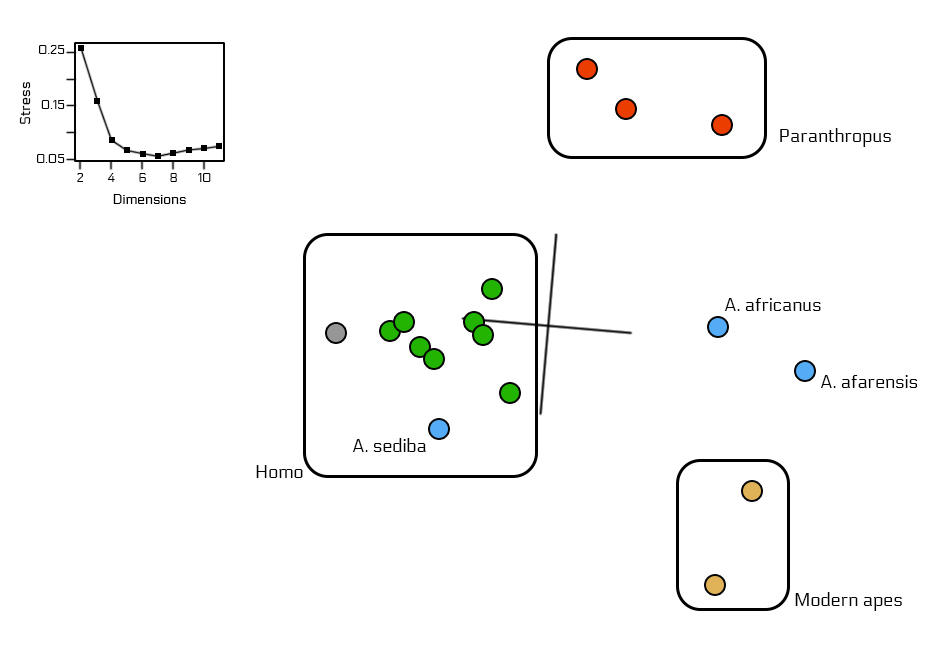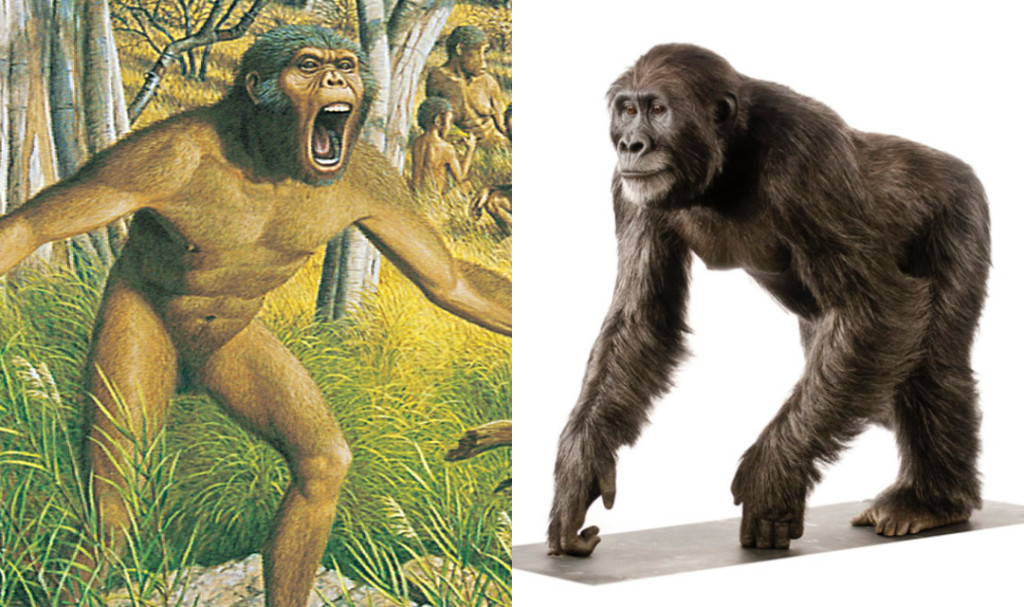
What About Apemen?
“Human evolution is the lengthy process of change by which people originated from apelike ancestors. Scientific evidence shows that the physical and behavioral traits shared by all people originated from apelike ancestors and evolved over a period of approximately six million years.”
– Smithsonian Institute, Introduction to Human Evolution1)
Universal Common Descent (UCD), one of the core principles of Darwinian science, states that all life on Earth has descended from a single common ancestor. This shared ancestry applies to ants, trees, dogs, mushrooms, and, most disturbingly to Christians, human beings. Contrary to the Bible’s description of mankind being created separately and distinct from the other animals, UCD would have us believe that Man evolved from ape-like ancestors over the course of many millions of years. To support this claim, Darwinists turn to a series of fossils popularly referred to as “apemen,” creatures that seem to unnervingly straddle the line between humans and lesser primates.
Despite the occasional hoax, most of these fossils appear to be genuine. What is the truth behind these bizarre creatures and how can we, as Christians, make sense of them?
Human Evolution According to Darwinism
If you have spent any time reading evolutionary material, you have probably seen a cladogram at some point. These graphs are created by passing large tables of biological data through a computer algorithm. This algorithm analyzes the data, collected from numerous species, and uses it to construct a hypothetical family tree, illustrating the evolutionary relationships between those species.
So what happens when the species analyzed are not related? Unfortunately, cladistics cannot account for such scenarios. Because cladistics assumes UCD, all organisms, no matter how different from each other, are considered to be related at some level. If this assumption is true, then it seems obvious that Man would be descended from ape-like creatures, as apes are the animals most similar to human beings.
While the assumption of common ancestry can be appropriate in some cases (such as when the organisms are members of the same created kind), it can also mask what are actually large differences between groups.
A Creation-based Look at “Apemen”
Creation scientists have devised their own way of organizing the natural world, through the rapidly developing field of baraminology (the study of “baramin,” or “created kinds”). Baraminology uses statistical methods that are similar to cladistsics to determine areas of continuity (where species show significant similarity) and discontinuity (where species show significant dissimilarity). Continuous species are considered to be members of the same baramin (or at least similar baramin), while discontinuous species are considered to be members of separate baramin. Unlike cladistics, however, baraminology does not assume any kind of ancestory or relationship between species beforehand, giving it a significant advantage over the older methods.

Three-dimensional MDS analysis demonstrating gaps separating humans from alleged non-human ancestors. Green circles represent Homo species, with Homo nailed shown in grey. Redrawn from Wood, 20172)
When humans, apes, and “apemen” are analyzed using baraminological methods, a very different picture emerges. Rather than showing the gradual transition from apes to humans predicted by Darwinists, statistical analysis reveals a clear and consistent discontinuity between these groups3). The placement of “apemen” in this schema varies between species.
Members of the genus Homo (e.g. Homo neanderthalensis, Homo habilis, etc.) fall squarely within the human cluster, a result supported by genetic evidence of interbreeding with modern humans4), as well as archaeological evidence of culture and intelligence among these groups5)6).

Left: A. afarensis as depicted by most evolutionary museums and textbooks. Right: A. afarensis as properly reconstructed based on current evidence. Image source.
Others, such as Paranthropus and the Australopithecines form continuous clusters that are distinct from both Man and modern apes. Although Paranthropus and Australopithecus are often portrayed as walking upright, like humans, further fossil evidence has shown that this is most likely wrong and that both creatures were actually knuckle walkers (not that this has stopped people from depicting them as bipedal anyway)7)8). This, combined with the statistical evidence, strongly suggests that the Paranthropoids and Australopithecines were not related to human beings and belonged to separate ape baramin.
Conclusion
Darwinists claim that the fossils of alleged “apemen” prove the evolution of human beings from lower, primate ancestors. When these same fossils are studied without assuming common descent, however, we see that large gaps separate these groups. Although the exact membership of each of these clusters is a subject of heated debate within the technical literature, the distance between these groups remains consistent, supporting the biblical view of Man, not as an advanced ape, but as a unique creation of God.
References
| ↑1 | “Introduction to Human Evolution.” The Smithsonian Institution’s Human Origins Program. May 24, 2017. Accessed April 22, 2018. http://humanorigins.si.edu/education/introduction-human-evolution. |
|---|---|
| ↑2 | Wood, Todd C. “Identifying Humans in the Fossil Record: A Further Response to O’Micks.” Answers Research Journal 10 (February 15, 2017). Accessed April 23, 2018). |
| ↑3 | Wood, 2017. |
| ↑4 | Green, R.E., et al., A draft sequence of the Neandertal genome. Science 328:710–722, 2010. |
| ↑5 | Madison, Paige. “Why We Should Bury the Idea That Human Rituals Are Unique – Paige Madison | Aeon Essays.” Aeon. Accessed April 23, 2018. https://aeon.co/essays/why-we-should-bury-the-idea-that-human-rituals-are-unique. |
| ↑6 | Hoffmann, Dirk L., Diego E. Angelucci, Valentín Villaverde, Josefina Zapata, and João Zilhão. “Symbolic Use of Marine Shells and Mineral Pigments by Iberian Neandertals 115,000 Years Ago.” Science Advances 4, no. 2 (2018). doi:10.1126/sciadv.aar5255. |
| ↑7 | Spoor, Fred, Bernard Wood, and Frans Zonneveld. “Implications of Early Hominid Labyrinthine Morphology Forevolution of Human Bipedal Locomotion.” Nature369, no. 6482 (1994): 645-48. doi:10.1038/369645a0. |
| ↑8 | Richmond, Brian G., and David S. Strait. “Evidence That Humans Evolved from a Knuckle-walking Ancestor.” Nature404, no. 6776 (2000): 382-85. doi:10.1038/35006045. |

